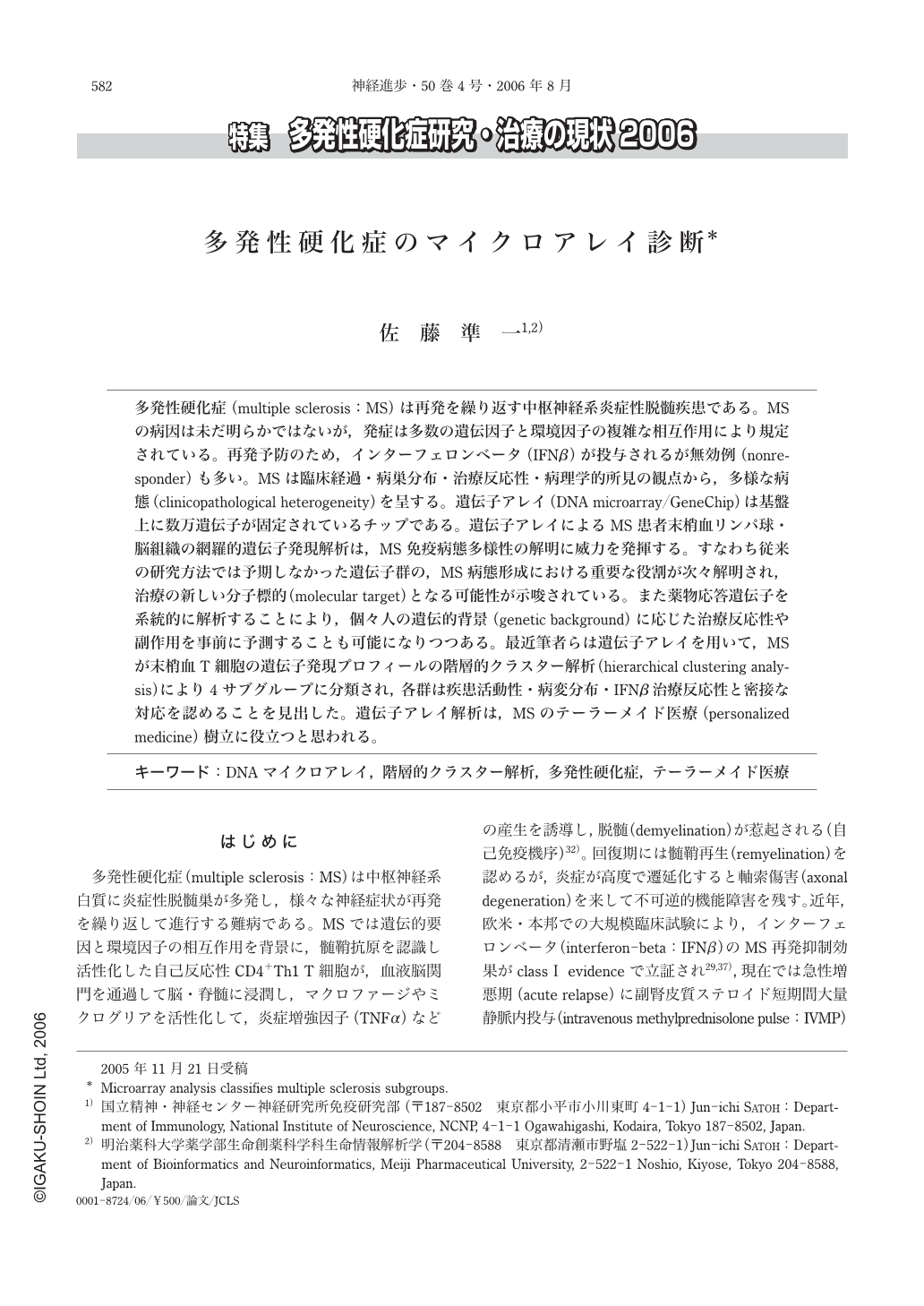Japanese
English
- 有料閲覧
- Abstract 文献概要
- 1ページ目 Look Inside
- 参考文献 Reference
多発性硬化症(multiple sclerosis:MS)は再発を繰り返す中枢神経系炎症性脱髄疾患である。MSの病因は未だ明らかではないが,発症は多数の遺伝因子と環境因子の複雑な相互作用により規定されている。再発予防のため,インターフェロンベータ(IFNβ)が投与されるが無効例(nonresponder)も多い。MSは臨床経過・病巣分布・治療反応性・病理学的所見の観点から,多様な病態(clinicopathological heterogeneity)を呈する。遺伝子アレイ(DNA microarray/GeneChip)は基盤上に数万遺伝子が固定されているチップである。遺伝子アレイによるMS患者末梢血リンパ球・脳組織の網羅的遺伝子発現解析は,MS免疫病態多様性の解明に威力を発揮する。すなわち従来の研究方法では予期しなかった遺伝子群の,MS病態形成における重要な役割が次々解明され,治療の新しい分子標的(molecular target)となる可能性が示唆されている。また薬物応答遺伝子を系統的に解析することにより,個々人の遺伝的背景(genetic background)に応じた治療反応性や副作用を事前に予測することも可能になりつつある。最近筆者らは遺伝子アレイを用いて,MSが末梢血T細胞の遺伝子発現プロフィールの階層的クラスター解析(hierarchical clustering analysis)により4サブグループに分類され,各群は疾患活動性・病変分布・IFNβ治療反応性と密接な対応を認めることを見出した。遺伝子アレイ解析は,MSのテーラーメイド医療(personalized medicine)樹立に役立つと思われる。
Multiple sclerosis(MS)is an inflammatory demyelinating disease of the central nervous system(CNS)white matter mediated by an autoimmune process, whose development is triggered by a complex interplay of multiple genetic and environmental factors. MS shows a great range of heterogeneity in terms of the disease course, lesion distribution, therapeutic response to IFNβ, and pathological aspects such as inflammation, antibody deposition, oligodendrocyte apoptosis, and axonal degeneration. These observations suggest that MS is a kind of neurological syndrome caused by different immunological mechanisms leading to the final common pathway that provokes inflammatory demyelination. DNA microarray technology is a novel approach to systematically monitoring the global expression of a large number of genes. It gives us new insights into the complexity of molecular interactions promoting the autoimmune process in MS. By microarray analysis followed by hierarchical clustering, we recently found that gene expression profiling of peripheral blood T lymphocytes discriminates four molecularly distinct subgroups of MS, associated with differential disease activity and therapeutic response to IFNβ. These observations suggest that microarray analysis is valuable for designing and optimizing personalized treatment for heterogeneous populations of MS.

Copyright © 2006, Igaku-Shoin Ltd. All rights reserved.


